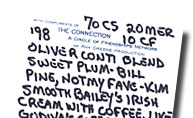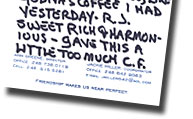
 ave
you ever wondered what it would be like to be a winemaker, blending
different varietals to come up with that special recipe for a truly
great wine? It's undoubtedly a fantasy that many wine lovers share, but
few will ever get the chance to experience, except perhaps for those few
willing to shell out $260 for the Jarvis Blending Kit. Designed
by Jarvis Winery
owner William Jarvis to simulate the
winemaking experience with blending exercises similar to those employed
by Jarvis winemaker Dimitri Tchelistcheff,
the kit includes six 375 ml bottles of 1999 Bordeaux varietals,
including two Cabernet Sauvignons and one each of Merlot,
Cabernet Franc, Malbec and Petite Verdot. You also
get two blending cylinders marked with exact percentages that total 100
ml each, and a fancy corkscrew/capsule cutter. The kit comes in a spiffy
box that could also serve admirably as a container for growing tomatoes
or peppers in the summer, so even that might be considered more than
flashy packaging.
ave
you ever wondered what it would be like to be a winemaker, blending
different varietals to come up with that special recipe for a truly
great wine? It's undoubtedly a fantasy that many wine lovers share, but
few will ever get the chance to experience, except perhaps for those few
willing to shell out $260 for the Jarvis Blending Kit. Designed
by Jarvis Winery
owner William Jarvis to simulate the
winemaking experience with blending exercises similar to those employed
by Jarvis winemaker Dimitri Tchelistcheff,
the kit includes six 375 ml bottles of 1999 Bordeaux varietals,
including two Cabernet Sauvignons and one each of Merlot,
Cabernet Franc, Malbec and Petite Verdot. You also
get two blending cylinders marked with exact percentages that total 100
ml each, and a fancy corkscrew/capsule cutter. The kit comes in a spiffy
box that could also serve admirably as a container for growing tomatoes
or peppers in the summer, so even that might be considered more than
flashy packaging.
The Psychopomp aka
Bill Schwab and I were discussing
the kit a while back, and we were intrigued by the concept, wondering
whether it might be a fun vehicle for an evening's entertainment, not to
mention providing us with the informational backbone to recommend the
kit and/or the wines in particular. A few
weeks later, Bill had one in his possession, courtesy of
Denise Hammerberg at the Jarvis
Winery. (A special tip of the top hat goes to Demorest Wines'
Roy Lombardo for facilitating the
transfer.) We set a date and gathered for a run through; Bill,
Kim Adams and this taster were
joined by that Wine Rackafratz
himself, R.J. Tibus. We started out
by evaluating the individual varietals, before going on to the blending
experiments. The wines all show a dark garnet color shading to pink at
the rim.
1999 Jarvis Napa Cabernet Sauvignon Estate, 13.2% alc., 24 months in
new Nevers French Oak: More in the red fruit spectrum than black,
this shows plenty of oak, with a solid earthy base. Kim noted
impressions of coffee and chocolate, while Bill added butterscotch and
caramel, calling the wine "woody as hell." (He meant that in the kindest
way, I'm sure.) Having only had
a few experiences with Jarvis wines, I'd
found those previous models to be more in the Bordeaux mold, so I was a
bit surprised, though not put off by the substantial oak. In fact, all
five components showed similar qualities, but 18 - 24 months in new
French Nevers barrels will do that. Still, they never seemed out of
balance, and if the older models are any indication, the oak should
integrate quite well.
1999 Jarvis Napa Cabernet Franc Estate,13% alc., 18 months in new
Nevers French Oak: Deeper and darker than the Cabernet Sauvignon,
and quite earthy, but then it should be if it follows the Napa template,
no? Bill gave impressions of "piney, woodsy, bright raspberry jam, a
little smoke and juniper."
1999 Jarvis Napa Merlot Estate, 13.8% alc., 18 months in new Nevers
French Oak: This is simpler than the Cab Sauv and Franc, with a
friendly, somewhat briary red fruit character; Bill observed that it's
mostly pure oak, with a little dark cherry in the background.
1999 Jarvis Napa Petite Verdot Estate, 13% alc., 24 months in new
Nevers French Oak: There's more going on in this one than in the
Merlot, though it's not as dense as the two Cabernets; it gives up black
and red currant flavors and aromas over an earthy base. R.J. described a
chocolate coconut perfume, but Bill only grunted that it's "all grip."
1999 Jarvis Napa Malbec Estate, 13% alc., 24 months in new Nevers
French Oak: Bill called this one "dark, brooding, meaty and pruney,"
and Kim added an impression of "a heavy cough drop." I found it to have
a briary, ripe cassis and black cherry personality.
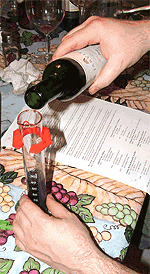 Having
run through all of these with quick short ounce pours, we were ready to
start blending. Bill had a notion as to a specific recipe that he wanted
to follow, rather than go with several specific percentages given with
the kit's instructions.
Having
run through all of these with quick short ounce pours, we were ready to
start blending. Bill had a notion as to a specific recipe that he wanted
to follow, rather than go with several specific percentages given with
the kit's instructions.
The Psychopomp Blend #1 consisted of 41% Cabernet Sauvignon,
23% Cabernet Franc, 6% Merlot, 9% Malbec and 21% Petite Verdot,
and showed chocolate over red and black fruit with just a hint of
tobacco. R.J. voiced impressions of cinnamon and red delicious, while
Bill commented that it was "simple fruity bright," and not as deep as
the recipe that Kim had measured out at the same time.
The 1995 Chateau Mouton Rothschild Blend (72% C.S., 20% Mer., 8%
C.F.) was very balanced and harmonious, with sweet rich fruit; Bill
called it dark and brooding, with a coffee, meat and cassis nose that
echoed in the lovely flavors. Like many of the recipes that followed,
this was definitely more than the sum of its parts. The Psychopomp
flippantly called out 847 points, but I had to disagree, as it had to be
900 points or better.
Kim tried her hand at another of the recipes given in the kit, and again
came up with a winner in the 1998 Chateau Margaux Blend (75% C.S.,
17% Mer., 5% P.V., 3% C.F.). It showed sweet floral, perfumed red
and black fruit, with a little briar in the background, garnering a much
more realistic 922 points from Bill.
It was RJ's turn to try his hand, so he flew by the seat of his pants
and came up with The Rackafratz Blend: 55% Petite Verdot, 20%
Cabernet Franc, 5% Cabernet Sauvignon and 20% Merlot. I found
this to be soft, harmonious and velvety smooth, with a chocolate over
red currant character; Bill had other ideas, calling it dark, tarry and
inky.
I figured I might as well try my hand at this blending stuff, so I
copped a recipe from a wine that Kim and I have been
enjoying over the last several months, the 1998 Oliver Conti
Emporda - Costa Brava,
consisting of 70% Cabernet Sauvignon, 20% Merlot and 10%
Cabernet Franc. I got a little twitch in my blending hand towards
the end, spilling a little extra Cab Franc into the measuring cylinder,
but it didn't seem to hurt the overall concoction. Another one that
showed sweet, rich, harmonious character, this one reminded R.J. of
smooth Bailey's Cream with coffee, or the Godiva's coffee he'd had the
day previous. Bill added an impression of sweet plum, but Kim noted a
hint of pine, saying it wasn't her favorite.
Kim then blended another couple of classics, starting with the 1997
Ch. Margaux Blend (85% C.S., 10% Mer., 5% P.V. & C.F.), which
featured coffee and a little earth over sweet red fruit, all with an
understated elegance. Bill added an impression of licorice, calling it
"sexy, like velvet." The 1995 Cheval Blanc Blend (50% Mer., 50% C.F.)
was a little earthier, even dirtier in character than either the Cab
Franc or Merlot respectively, but nevertheless, it was quite enjoyable.
On the whole the recipe blends that come with the kit seemed to work
much better than the fly - by - the - seat - of - the - pants blends,
but that shouldn't dissuade blenders from trying out their own
percentages, and that's just what Bill did with his Psychopomp Blend
#2. Consisting of 61% Cabernet Sauvignon, 29% Merlot, 5% Cabernet
Franc, 3% Malbec and 2% Petite Verdot, this was smooth and
rich, but not as sweet as many of the other blends, being claret - like,
with a little spice. R.J. was reminded of "bar-b-q heaven," noting some
hickory smoke and roasted animal, calling it "bluer and jammier." Bill
simply found this to have a little more heat than the others.
We finished off with Jarvis' own 1996 Lake William Blend (37% C.S.,
38% Mer., 25% C.F.). It was nice and chocolaty, with thick red and
black fruit over an earthy base.
So what was the verdict? Did we have fun with this, and would we
recommend it to those with the disposable income and the inclination to
indulge in such a singularly geeky pastime? Absolutely. As previously
stated, many of the recipe blends transcended the sum of their
components, and we had a great time playing with the kit. This would make a great party item for a group of four to six people
with a few hours to spend blending and tasting some high quality Napa
reds and seeing just how much changing the percentages of varietals
alters the personality of the wines. 939 points!
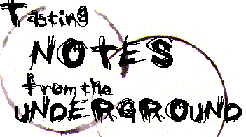

 Reporting from Day-twah,
Reporting from Day-twah,
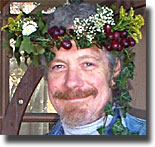

 ave
you ever wondered what it would be like to be a winemaker, blending
different varietals to come up with that special recipe for a truly
great wine? It's undoubtedly a fantasy that many wine lovers share, but
few will ever get the chance to experience, except perhaps for those few
willing to shell out $260 for the Jarvis Blending Kit. Designed
by
ave
you ever wondered what it would be like to be a winemaker, blending
different varietals to come up with that special recipe for a truly
great wine? It's undoubtedly a fantasy that many wine lovers share, but
few will ever get the chance to experience, except perhaps for those few
willing to shell out $260 for the Jarvis Blending Kit. Designed
by 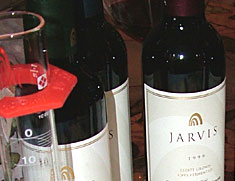
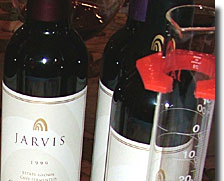
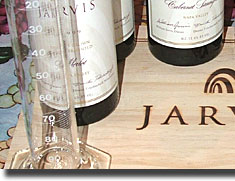
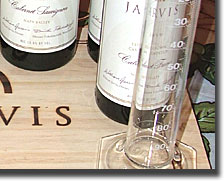
 Having
run through all of these with quick short ounce pours, we were ready to
start blending. Bill had a notion as to a specific recipe that he wanted
to follow, rather than go with several specific percentages given with
the kit's instructions.
Having
run through all of these with quick short ounce pours, we were ready to
start blending. Bill had a notion as to a specific recipe that he wanted
to follow, rather than go with several specific percentages given with
the kit's instructions. 